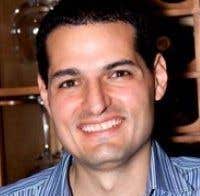Here is Alder Yarrow's first monthly despatch from the US on what is currently preoccupying American wine lovers. To mark the beginning of this new chapter, we are making this first column free for all to view but subsequent articles will be for Purple pagers only.
Napa Valley has been awash with nervous energy for the past week. And it has nothing to do with the nearly magical reprieve that Mother Nature seems to have granted the 2011 harvest after unseasonably fierce rains.
On the surface, everyone pretends it's just another week in wine country but behind closed doors and in hushed tones over beers in the local bars, everyone seems to be talking about the handsome stranger in town.
This past week, for the first time in more than 25 years, the wine critic Robert M Parker Jr, did not make his annual pilgrimage to taste the wines of Napa Valley, choosing instead to send a young man named Antonio Galloni.
When Robert M Parker Jr announced to his subscribers this past February that henceforth he would no longer be reviewing California wines, and was instead passing this responsibility to his colleague Galloni, the news quickly rippled through the American wine industry.
Reactions to the news ranged widely – from delight, to indigestion, to deft satire – all steeped in the knowledge that a distinct chapter in the history of American wine criticism had come to a close.
Parker's rise to prominence was matched by (and some suggest responsible for) the ascendancy of fine wine in California. While some argue Parker's influence alone could not have created the cult wines of California, none can dispute that wines from Screaming Eagle to Sine Qua Non owe much of their fame and fortune to the 100-point scores they repeatedly received from Parker.
Now, those at the top of the pyramid have only one direction they can go, and more than a few people are rooting for the mighty to fall at the hands of a new king-maker.
Antonio Galloni joined Robert Parker's Wine Advocate newsletter in 2006 as the reviewer for Italian wine, largely due to the success and reputation of his self-published Piedmont Report newsletter, which covered the wines of that region in great depth, with an emphasis on the traditionalists. Over the course of his tenure at the Wine Advocate, his responsibilities expanded to include coverage of Champagne and, concurrent with his newest appointment, now also include the Côte d'Or and Chablis.
Rampant speculation as to whether the established hierarchy of California wine was about to undergo a seismic change under the scrutiny of a new palate would have been true no matter to whom Parker passed the torch. But Galloni was a particularly interesting choice, with his past focus on Italian and French wines and an ostensibly more European sensibility. Would Galloni's appointment spell the death of the so-called 'hedonistic fruit bombs' that many see as the bane of an industry slavishly devoted to pleasing the Parker palate?
While I count myself among those who credit Parker with an appreciation for a much broader range of wines than the 'monolithic palate' cited frequently by his critics, I must admit that the prospect of Galloni's perspective on California holds a certain appeal. As a fan of some of Italy's more esoteric and eccentric wines, I've come to appreciate Galloni for his critical acclaim for wines that Parker either didn't enjoy or never bothered to taste.
The idea that Galloni's palate might be more sympathetic to acid and structure certainly appeals to a lot of California winemakers, especially those who are consciously striving against and away from the excesses of fruit, glycerin and alcohol that mark many of Parker's perennial favourites.
'The word on the street is that balance is an important concept to [Galloni]', noted Jeff Smith, proprietor of Hourglass Vineyard in Napa, who is interested to see how Galloni's views of his wines compare with those of Parker, who has been very kind to Hourglass over the years, but seems not to have cared greatly for the 2008 vintage. 'I look at it as an exciting thing', said winemaker Thomas Brown, 'and I would hope a lot of other people would too. But I can understand that if you're tight with Parker and used to hitting it out of the park every year, change could be bad for you. And that includes some of the wines I make.' Brown's work for clients such as Schrader, Outpost and Maybach has regularly earned 100-point marks from Parker.
Brown, who knows Galloni personally and has tasted old Italian wines and burgundies with him on more than one occasion, characterises his palate as 'definitely more European' than Parker's, and notes that he tends to be much less forthcoming with high scores than his boss.
'Over time', continued Brown, 'he's definitely broadened his appreciation for a wider range of wines. When he moved to reviewing all of Italy for the Wine Advocate, you saw wines like Sandrone and La Spinetta getting the same kind of scores as Giacosa and Conterno.'
This appreciation for many styles of wine, combined with Galloni's age, has Brown particularly excited to have him on the case in California.
'He's what, 40?', said Brown. 'Here's the first time ever that we've got someone our own age as a majorly influential critic covering our region. It's going to be like talking to a peer. It's cool to have a younger wine geek pulled into the mix. It's going to be fun.'
Brown dismissed the idea that Galloni would upset the old order in Napa. 'The top wines are still going to get the standard-bearer scores. You might just see a lot of scores get the 'minus two', he said, referencing Galloni's stricter scoring.
Brown is likely correct. Galloni, despite having complete editorial freedom, nonetheless must protect the brand for which he works. This fact alone dramatically curbs the likelihood that Galloni would trash wines and wineries that have long been vaunted by the Wine Advocate. Leaving aside the degree of disrespect for his own boss this would represent, it certainly wouldn't be good for continued access to some of California's most unavailable wines, nor for the circulation numbers that rest on reviews of the same.
But even a stricter grading curve could have a fairly dramatic effect on those wines at the very top of the pyramid. A 100-point score, no matter whose, guarantees a certain demand for a wine, as well as dramatically influencing the value of that wine on the secondary market. Wines with two 100-point scores, from, say, Parker and the Wine Spectator, often sell for 50 to 100 per cent more than wines with a single 100-point score coupled with a 98-point score. Not unlike the first growths, many cult wineries rely on the secondary market value for their wines to justify their extremely high release pricing at three-digit figures per bottle.
This past week in Napa was not the first trip that Galloni has made to California in his new capacity.
Galloni's first reviews of California wines came out this past August, with his assessments of the wines of the Central Coast and Santa Cruz Mountains.
By all accounts, Galloni took his first foray into California quite seriously.
'Galloni struck me as very curious about what he was doing', said Jason Haas, partner and general manager of Tablas Creek Vineyards, established by his father Robert Haas and the Perrin family of Château de Beaucastel. 'He was a thoughtful taster who seemed committed to getting it right, and quite serious about what he was doing. I was impressed.'
The Tablas Creek Vineyards wines, which are made in a distinctly European style, fared well under Galloni's scrutiny, perhaps with only a slight edge above Parker's scores that may be due as much to the vintage as to anything else.
If Galloni's scores for the rest of the wines he reviewed during his first foray into California are any indication of what Napa has in store, few people have much to worry about. But there may be some glimmers of exciting change to come for some. While Galloni did not bestow a single 100-point score, top scores went to all the usual suspects including Ridge, Saxum, Alban and Sine Qua Non.
Looking deeper into the field, however, Galloni bestowed significantly higher scores than Parker has historically on wineries such as Andrew Murray Vineyards, and also gave high marks to wines that have never been reviewed by Parker, such as the Chanin Wine Company. On only a few occasions did Galloni's scores significantly run counter to Parker's scores for the same wines (which Parker tasted in barrel the previous year). Galloni's assessments of Jonata's wines, for instance, were generally several points higher than Parker's.
Napa, then, will in all likelihood fare similarly. The upper-echelon wines such as Colgin, Harlan Estate, Dominus, Screaming Eagle, Abreu, and Shafer will likely see more 98s than 100s, while there is a chance that some producers who have never matched Parker's ideal may get a chance to shine.
The first hint of the latter came in a short post that Galloni made to the bulletin board on Parker's website last week after a day spent tasting the wines of the Napa Valley Vintners association. In it, he mentioned among his 'highlights of the day' the wines of Cathy Corison. Balanced, beautiful, and rarely above 14% alcohol, these wines, which are among my personal favourites in Napa [mine too – JR], have always been tepidly received by Parker, who found them 'closed', 'difficult' and 'muted' on the very few occasions he has ever reviewed them.
Harvest is always a time of change, so perhaps it is fitting that as Napa winemakers scramble to harvest their only-just ripened vintage, the whole region will be seen from a new vantage point.
Galloni's coverage of Napa Valley is scheduled to debut in the December issue of the Wine Advocate.

